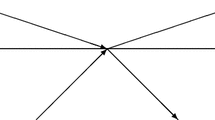Abstract
We have known for almost three decades that the steps in a computer that require a minimal energy expenditure, that cannot be avoided by any means, are those that discard information. For more than half that period we have known that such steps are not essential; computation can be carried out through a sequence of logical 1:1 mappings. Computation, therefore, can be carried out with arbitrarily little dissipation per step, if done sufficiently slowly. Much more recently it has been emphasized that measurement and communication are similar to computation; it is only the information-discarding steps that have a lower bound on the dissipation. Such steps are not required in communication. In measurement, as shown by Bennett, they only become essential when we reset the meter for its next (or first) use. This paper is not a detailed exposition of all this, but only an annotated guide to the existing literature.
Similar content being viewed by others
References
J. C. Maxwell,Theory of Heat (Longmans, Green, London, 1871), p. 308.
C. E. Shannon,Bell Syst. Techn. J. 27:397, 623 (1984).
M. D. Sturge, inNo Way, P. J. Davis and D. Park, eds. (Freeman, New York, 1987), p. 111.
P. W. Smith,Phil. Trans. R. Soc. Lond. A 313:349 (1984); J. D. Meindl,IEEE Trans. Elect. Devices ED-31:1555 (1984); J. D. Meindl, inCutting Edge Technologies (National Academy Press, Washington, D.C., 1984), p. 5.
L. B. Levitin,Int. J. Theor. Phys. 21:299 (1982); H. J. Bremermann,Int. J. Theor. Phys. 21:203 (1982).
R. Landauer,Int. J. Theor. Phys. 21:283 (1982).
R. Landauer,Found. Phys. 16:551 (1986).
L. Brillouin,Science and Information Theory (Academic Press, New York, 1956).
R. Landauer,IBM J. Res. Dev. 5:183 (1961).
C. H. Bennett,IBM J. Res. Dev. 17:525 (1973).
J. A. Wheeler and W. H. Zurek, eds.,Quantum Theory and Measurement (Princeton University Press, Princeton, New Jersey, 1983), p. 782.
K. Obermayer, G. Mahler, and H. Haken,Phys. Rev. Lett. 58:1792 (1987); J. Maddox,Nature 327:97 (1987); S. Hawking,New Sci. 115:46 (July 9, 1987); O. Costa de Beauregard,Found. Phys., to be published; J. Rothstein, inPerformance Limits in Communication, J. K. Skwirzynski, ed. (Kluwer Academic, Dordrecht, in press); W. Porod, R. O. Grondin, D. K. Ferry, and G. Porod,Phys. Rev. Lett. 52:232 (1984); W. Porod, R. O. Grondin, D. K. Ferry, and G. Porod,Phys. Rev. Lett. 53:1206 (1984); C. Mead and L. Conway,Introduction to VLSI Systems (Addison-Wesley, Reading, Massachusetts, 1980), Chapter 9; H. M. Hastings and S. Waner,Biosystems 17:241 (1985); E. M. Drogin,Defense Electron.1986 (March):31.
J. von Neumann,Non-linear capacitance or inductance switching, amplifying and memory organs, U.S. Patent 2,815,488; E. Goto,J. Elec. Commun. Eng. Jpn. 38:770 (1955).
R. W. Keyes and R. Landauer,IBM J. Res. Dev. 14:152 (1970).
K. K. Likharev,Int. J. Theor. Phys. 21:311 (1982); K. K. Likharev, S. V. Rylov, and V. K. Semenov,IEEE Trans. Magn. 21:947 (1985).
R. Landauer, inDer Informationsbegriff in Technik und Wissenschaft, O. G. Folberth, C. Hackl, eds. (R. Oldenbourg, Munich, 1986), p. 139.
D. M. Greenberger, ed.,New Techniques and Ideas in Quantum Measurement Theory (New York Academy of Science, 1986); M. Roth and A. Inomata, eds.,Fundamental Questions in Quantum Mechanics (Gordon and Breach, New York, 1986).
C. H. Bennett,Int. J. Theor. Phys. 21:905 (1982); C. H. Bennett,Sci. Am. 255:108 (1987); C. H. Bennett,IBM J. Res. Dev. 32:16 (1988).
E. E. Daub,Hist. Phil. Sci. 1:213 (1970).
O. Costa de Beauregard,Time, The Physical Magnitude (Reidel, Dordrecht, 1987), p. 153.
R. Landauer, inSignal Processing, S. Haykin, ed. (Prentice-Hall, Englewood Cliffs, New Jersey, in press).
H. Marko,Kybernetik 2:274 (1965); F. T. S. Yu, inOptics and Information Theory (Wiley, New York, 1976); J. R. Pierce, E. C. Posner, and R. Rodemich,IEEE Trans. Inf. Theory 27:61 (1981).
R. Landauer,Appl. Phys. Lett. 51:2056 (1987).
R. Landauer,IEEE Spectrum 4:105 (1967).
R. Landauer,Z. Phys. B 68:217 (1987).
Author information
Authors and Affiliations
Rights and permissions
About this article
Cite this article
Landauer, R. Dissipation and noise immunity in computation, measurement, and communication. J Stat Phys 54, 1509–1517 (1989). https://doi.org/10.1007/BF01044731
Received:
Issue Date:
DOI: https://doi.org/10.1007/BF01044731




